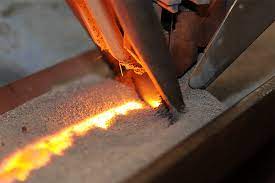People, particularly novice welders, tend to make the mistake of believing that welding is a very simple process – after all, it simply involves picking up the welding gun and firing it in the general direction of the project right? Well, in some cases it might be that simple, but today we are going to discuss a few different types of welding and how they might change your outlook on the welding process. There is a different welding type for almost every situation, and using the right process is vital to the success of your project. To begin, we will discuss electroslag welding and its various applications.
Electroslag Welding
Single Pass Method
Patented by Robert K Hopkins, United States, February 1940
As far as production and general use go, electroslag welding (referred to hereafter as ESW) is a single pass method, and it was designed for thicker materials in a vertical position. This could include thicker walls, the interior of chemical vats, or even train cars. In other words, welding isn’t always a project you perform in your garage at home, and sometimes you will not be in a position to manipulate the welding surface to your desires.
ESW begins with an ARC of course, and that arc will be struck by a wire which is pushed into the weld surface. At some point the molten slag will extinguish the arc and a copper retaining shoe will serve to keep the slag in place while you are welding. In other words, the vertical nature of the weld process will not cause anomalies after the fact. In addition to that, the copper shoe will keep the process relatively safe, and it can in fact be cooled by water during the welding process.
It should be noted that the process of electroslag welding does start with an arc but once the welding process begins the arc is extinguished and it is no longer considered to be an arc process. Though this process may not be the best when it comes to basic home projects, it will certainly shine in the industrial areas.
Flux-Cored-Arc Welding
Multi-Type
Debuted in Early 1950
The fluxed-core process is often though to be an automatic welding process, and in order to utilize this method one will need a constantly-fed consumable electrode that contains a flux as well as constant voltage. Most arc welding types will call for an external gas to shield the electrode; however the flux involved in the FCAW process often provides adequate shielding from the atmosphere. The largest advantage delivered by the flux-cored method is the fact that stick electrodes are no longer needed, and the process is much faster.
It should be noted of course that now all FCAW methods can be utilized without a shielding gas. Dual shield welding is a method developed for structural welds, and it utilizes both the flux-cored electrode along with an external shielding gas. This method will provide a thicker weld for metals that have moved out of their intended position. The method will produce fewer weld defects and ensure that the welder does not need to stop constantly in the interest of obtaining a new electrode to continue the job at hand.
Gas Tungsten Arc Welding
Referred to as Tungsten Inert Gas (TIG) Welding
Developed in 1944
This is yet another arc welding process that utilizes a non-consumable tungsten electrode for the welding process.
The process itself is often used for welding aluminum alloys in existence today, and some of the highest quality welds today are created with this process. The most common application for GTAW is the welding of stainless steel sections as well as non-ferrous metals. These could of course include the following:
- Aluminum
- Magnesium
- Copper
To begin, a generator will create an electric spark, and this spark will create a path through the shielding glass rendering it possible for the arc to enter. Note that this does create a high frequency burst, and as a result it may be damaging to some vehicle systems, particularly the electronics. In a world where vehicles are largely dependent upon their electronics, it becomes very important for the electrical systems to be preserved and protected as a single mistake can completely disable the vehicle.
These are three out of several dozen welding types, and it is important for you to master the majority of them if you wish to become an effective welder. That being said, it’s time for you to invest in these skills and learn some new ones in the process.

